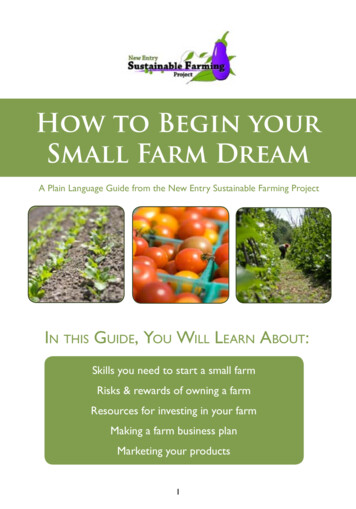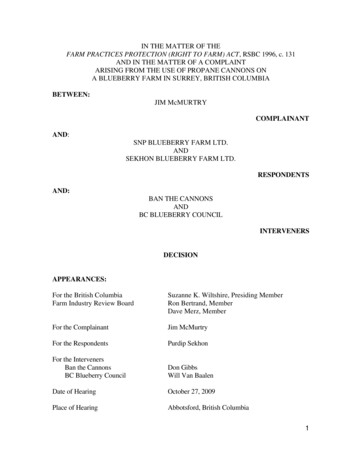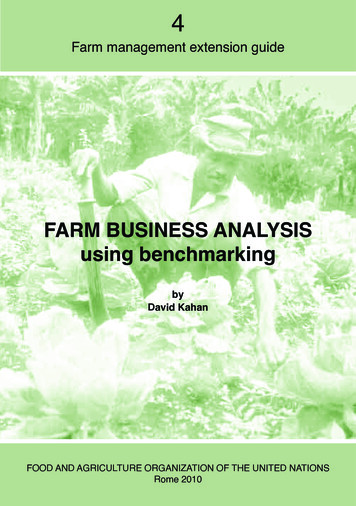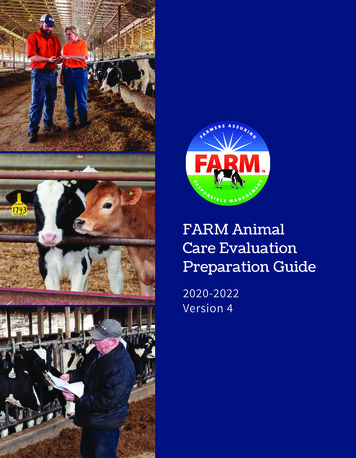
Transcription
Regulating the Farm:Improving Agriculture’s Viability in the Capitol RegionFisher Farms, Town of FarmingtonFunded by the Connecticut Department of AgricultureAgriculture Viability Grant ProgramJuly 2007Capitol Region Council of GovernmentsTown of AvonTown of BloomfieldTown of East GranbyTown of East WindsorTown of EllingtonTown of EnfieldTown of FarmingtonTown of GranbyTown of SomersTown of TollandTown of Wethersfield1
Capitol Region Council of GovernmentsAgriculture Viability ProjectIntroductionWhile many state and local agricultural policy efforts focus on the permanentpreservation of working lands, farming operations and farmers need more than protectedland to operate in a sustainable manner in the Capitol Region. Farms are businesses thatcontribute significantly to local, regional and state economic development and security,job creation, tax bases, natural resource protection and quality of life. However, farms arealso businesses that face challenges that are unique in the regional economy.The Capitol Region is comprised of 29 communities in the fertile upper ConnecticutRiver Valley, including parts of both Hartford and Tolland Counties. Many rural andsuburban municipalities in the Region contain some of the State’s most importantagricultural soils. According to the 2002 Census of Agriculture, there were 1,122 farms inHartford and Tolland Counties with a combined market value production of 154,943,000.1 The economic impact of these farms extends well beyond the value oftheir market production. Farmers provide jobs directly and indirectly through theirconsumption of fuel, equipment, insurance, and other items and services. Furthermore,the 15 farmers’ markets and 34 farm stands in the Capitol Region also contribute to theregional economy both directly and indirectly. 2 In a 2000 survey, 76% of Connecticutrespondents indicated that they had visited a pick- your-own farm, farm stand or other onfarm event. In addition, regional farms can attract more than just local residents; agritourism has recently increased in other New England states and can be expected to do thesame in Connecticut. 3 Finally, working lands are fundamental to the character of the Stateand the Region, lending greater vitality to the larger tourism sector.Recognizing the significance of agriculture to the local and regional econo my, characterand quality of life, eleven Capitol Region municipalities participated in this cooperativeeffort to help ensure that the local regulatory climate is conducive to the continued,profitable operation of farms within their boundaries. 4 These eleven towns contain morethan 25,000 acres of active farmland and some 200 individual farming businesses thatrange from large corporate nurseries to small vegetable or haying operations.Agricultural businesses have very different needs from other businesses, especially withrespect to land use. Farms frequently have multiple land uses on single parcels, and canbe hindered by regulations that may limit a farm’s flexibility to produce, add value to,store, and/or market products on the same site on which a farmer might also live.Traditional zoning regulations tend to separate such varying uses. But given the changingnature of agricultural markets, as well as the recent rise of agri-tourism, traditional zoningcan actually prohibit farmers from reaching their full potential. Also, many Connecticut1USDA, New England Agricultural Statistical Service, 2002 Census of Agriculture County Profiles:Hartford and Tolland, Connecticut, x.htm .2Connecticut Department of Agriculture, 2005 Farmers’ Markets and 2005 Farm Map.3Working Lands Alliance, A Call to Farms! A Mid-Decade Look at Connecticut’s Agricultural Lands 2005.4The eleven participating municipalities are: Avon, Bloomfield, East Granby, East Windsor, Ellington,Enfield, Farmington, Granby, Somers, Tolland, and Wethersfield.2
Capitol Region Council of GovernmentsAgriculture Viability Projectfarmers work on land in multiple municipalities. Regulations, policies and attitudes aboutfarming can vary between towns, further complicating business operations for farmers.This project has worked with farm business owners and municipal officials to identifyopportunities to improve agricultural regulations and offer recommendations forachieving greater regulatory consistency across municipalities.MethodsCRCOG and American Farmland Trust staff interviewed planners and zoningenforcement officials in individual participating municipalities to gauge their concerns onagricultural land uses and understand their current regulations. In addition, CRCOGorganized three listening sessions involving different types of agricultural producers,from wholesalers to retailers and agri-tourism business operators. Those attending thesesessions voiced concerns about municipal regulations and policies and offeredsuggestions for improvements. CRCOG staff followed up on these ideas and researchedbest practices and alternatives from around the U.S. for regulating agricultural businesses.The outreach and research undertaken in this project culminated in the recommendationscontained in this report. The project benefited throughout from the review and insights ofindividuals and organizations involved in agriculture, including the Connecticut FarmBureau, the American Farmland Trust, and UCONN Extension staff.Municipal ConcernsFollowing is a summary of agricultural business-related issues and concerns raised byplanners and zoning enforcement officials in the participating municipalities duringinterviews with CRCOG staff:§Towns want to support agricultural businesses by allowing and encouragingcreative, entrepreneurial uses.§Concern about when agricultural uses become more commercial or retail than“agricultural.”§Wide variation among towns in basic regulations, such as the definition of “farm.”§Town staff generally support putting notes on land records or deeds in newsubdivisions that abut farm uses to minimize complaints about agricultural uses(however, not all towns require this).§Farm stands and markets are desired, but applicable regulations vary from town totown.§Some regulations require a percentage of on-site production of farm stand/marketgoods to insure the agricultural nature of the business (as opposed to apredominantly retail use); however, municipal staff not always capable ofenforcing such provisions.3
Capitol Region Council of GovernmentsAgriculture Viability Project§Towns want to encourage “value-added” facilities for production, but regulationsvary, ranging from requiring additional home-business permits to allowing suchuses as-of-right.§Towns are increasingly adopting regulations on horse stables and riding arenas, asthese uses expand, but regulations vary.§Greenhouses and nurseries raise concerns about fertilizers, pesticides and soilloss.§Most towns informally exempt seasonal farm signs from regulation, leavingfarmers vulnerable to complaints.§Some towns require special events permits for seasonal farm events.§Non-agricultural uses on farms (i.e., leasing barns for storage) are not a majorconcern.§Enforcement tends to be prompted by complaints; most towns try to educate boththe party making the complaint and the farm owner to resolve issues.CRCOG staff also reviewed the zoning regulations of the 11 participating communities.The table below summarizes the number of towns with existing regulations that addressagricultural uses.Existing Farm-related Bylaws in the 11 Participating TownsBylaws that apply to.Agriculture definitions/uses11Structures10Farm es6Conservation6Laborer housing4Aquifer protection4Special events permit3Processing/"value-added"3Nurseries/tree farms3Timber2Subdivision buffers2024Number of TownswithapplicableregulationsParticipating TownsAvonEnfieldBloomfield FarmingtonEast Granby GranbyEast WindsorSomersEllingtonTollandWethersfie6810124
Capitol Region Council of GovernmentsAgriculture Viability ProjectFarm Business ConcernsIn December 2006, CRCOG facilitatedthree Listening Sessions at theConnecticut Farm Bureau Associationoffice. A total of 43 attendees representingfarm businesses and organizations sharedtheir concerns about the effects of existingmunicipal bylaws on agriculturalbusinesses.Following are summaries of theselistening sessions.Session 1:Wholesalers (December 5, 2006)Attendees:17Agricultural BusinessOwners:15 representing 12 farm businesses including dairy, flowers,beef/other livestock, nurseries/greenhouses, orchard, timber,tobacco, vineyard, horse, hay, bee-keeping, poultry, farmstand, and vegetables. Businesses located in East Granby,East Windsor, Ellington, Enfield, Granby, Hartland,Simsbury, Somers, Stafford, Suffield, and Windsor.Organizations/Agencies:Connecticut Farm Bureau Associa tion, American FarmlandTrustConcerns§Municipal officials need to be better educated about agriculture and/or makebetter use of resources like Connecticut Dept. of Agriculture, agriculturalorganizations, UConn Extension, and others.§Officials, boards and commissions need to demonstrate commitment to preservingworking farms, not just protecting open space from development.§Need more consistency in regulations and enforcement among towns.§Need more consistency among town departments, staff and commissio ns forregulation and enforcement.§Need better definitions of agriculture.§Strong and clear policies for preservation, economic development, and promotionof working farms should be written into local Plans of Conservation andDevelopment. Goals could be stated in terms of number of agriculturalbusinesses, economic impact, rather than just a percentage of farmland to beprotected.§Agri-business zoning districts should be explored.5
Capitol Region Council of GovernmentsAgriculture Viability Project§Agricultural commissions, either local or regional, should be explored to: 1)provide advice to towns, 2) advocate for farmers, and 3) serve as liaison. Aregional commission may make more sense.§The costs and time required for permitting and application processing isburdensome to farm businesses and does not account for seasona l agriculturalinterests or demands.Session 2:Retailers (December 11, 2006)Attendees:16Agricultural BusinessOwners:14 producers representing 11 farm businesses includingbeef/other livestock, tobacco, flowers, farm stands, orchards,vegetables, berries, pick-your-own, CSA, bee-keeping, maplesugarhouse, hay, and Christmas trees. Businesses located inAvon, East Windsor, Ellington, Enfield, Granby, Litchfield,Somers, Suffield, and Wethersfield.Organizations/Agencies:Connecticut Farm Bureau Association, American FarmlandTrustConcerns:§Signs – Inconsistent enforcement ofregulations within towns, classification offarm signs (commercial vs. political), lengthof display time allowed (annual permits),placement restrictions, limitations onadditional words/signs as crops come inseason, and others. Farms need to advertiseto survive.§Inconsistent implementation andenforcement of building, health and firecodes between towns can lead to costlydelays, requirements, permitting, and otherproblems.§There is a preference for operating “under the radar” of local governmentsbecause of a perception that with attention comes more regulation andenforcement.§Farm business owners understand the desire to prevent stands from being 100%retail; however, some regulations require unrealistically high percentages of onsite production that are not sensitive to crop losses, cooperative farming venturesand other realities (see New Haven Farmers Market for successful example).6
Capitol Region Council of GovernmentsAgriculture Viability Project§Municipal, state and federal officials need to be better educated about agriculture.Town zoning enforcement officials need to have more personal interactions withfarming community, especially when dealing with ag/residential complaints orconflicts.§Open Space – Stronger regulations specific to farmland could help reducedevelopment of prime open space parcels.§Wetlands – Cost of permits for stream draws and/or work in wetlands a concern.§Livestock – Enforcement is inconsistent.§Structures – Cost of meeting access requirements (i.e. bathrooms) is prohibitive.§Health code-related – Seasonal and/or temporary cooking facilities require moresensitivity to waster water requirements; not the same as full commercialoperations.§Definitions – Simple, universal definitions of “agriculture,” “farmers market” andother key terms would be a big help.§Mixed reaction to the idea of a regional agricultural commission; role andfunctions need to be clarified.Session 3:Agri-Tourism Business Operators (December 13, 2006)Attendees:10Agricultural BusinessOwners:7 producers representing 6 farm businesses including farmstands, greenhouses, tobacco, vegetables, flowers, timber,orchard, berries, pick-your-own, livestock (for petting).Businesses located in East Windsor, Enfield, and Somers.Organizations/Agencies:Connecticut Department of Agriculture, Connecticut FarmBureau Association, American Farmland TrustConcerns:§Signs – Lack of consistent guidanceand enforcement among and withintowns; mobile signs (i.e., trucks) are aprincipal reason for frustration;requirements for drawings, visualimpacts are excessive, especially fortemporary signs.§Greenhouses – Regulations areinconsistent for hoop houses,accessory structures.7
Capitol Region Council of GovernmentsAgriculture Viability Project§On-premises product requirements of 80% or greater are unrealistic, especially ifweather-related losses are suffered; a commitment to a percentage of“Connecticut- grown” or “New England-grown” products should be requiredand/or rewarded; labeling for local and/or on-site produced is important todistinguish “legitimate” farms.§Pick-Your-Own – Permit requirements (i.e., 150 per weekend) are costprohibitive and discourage businesses.§Farm Stands – Should be allowed by right for operating farms and allowed onlyby special permit for retail operations without active farming; the “Right to Farm”statute should protect limited retail sales for legitimate farm businesses.§Parking – No problems reported.§Retail – Greater flexibility in allowing “added value” retail options is essential ifsmall Connecticut farms are to survive; enhanced marketing and educationcampaigns like the “Local Hero” program in Western Massachusetts may besuccessful in Connecticut.§Regional Agricultural Commission – Could be effective, especially if it functionsas an impartial, unbiased educator/arbiter for municipal regulatory permitting anddisputes; UConn has fulfilled this role to some degree already; the ConnecticutEnvironmental Review team offers a possible model.§The availability of a property tax exemption on farm structures up to 100,000allowed by CT Public Act 03-234 should be more widely promoted.8
Capitol Region Council of GovernmentsAgriculture Viability ProjectRecommendationsBased on the concerns expressed by municipal officials and farm business owners,CRCOG identified priority regulatory concerns, including definitions of agriculture,structures, farm stands, signage, and alternative uses. (Several other policy issues alsoclearly warranted mention, but could not be fully addressed within the scope of thisproject.)CRCOG staff researched agricultural business regulations in other states andmunicipalities around the U.S. to develop draft recommendations. Comments on thesedraft recommendations were requested from agricultural organizations, includingAmerican Farmland Trust, Connecticut Farm Bureau and the Cooperative ExtensionProgram at the University of Connecticut, as well as the project’s participatingmunicipalities and listening session participants. This feedback was incorporated in thefollowing final recommendations.RECOMMENDATION 1Address policy issues.Include a clear focus on agriculture in municipal Plans of Conservation andDevelopment. Inventory agricultural lands and businesses, and account for the economiccontributions of the agricultural sector, as well as its contributions to communitycharacter. Include language about protecting working farms and farm businesses, not justland, as plans provide the basis for regulations and interpretation of regulations. (Seeattached examples.)Reduce nuisance complaints from residents located adjacent to agricultural uses.Reference state “Right to Farm” law, Connecticut General Statutes § 19a-341, onsubdivision plans or deeds. Seek to provide agricultural buffers on new subdivisions.Educate town staff and land use officials about agricultural uses. Take advantage ofassistance offered by the Connecticut Department of Agriculture, the U.S. Department ofAgriculture’s Natural Resources Conservation Service, UCONN Extension System, theConnecticut Farm Bureau, and other agricultural organizations. Use references materialssuch as the forthcoming American Farmland Trust /CT Conference of MunicipalitiesGuide to Planning for Agriculture.Adopt consistent messages and approaches to regulating and working withagricultural businesses across municipal departments. From building officials tozoning enforcement officers, town staff needs to find ways to promote agricultureviability along with public health, safety and welfare.Explore the concept of regional agricultural commissions. Such bodies could serve asliaisons between, and educators of, farmers and regulators. Though it may not be feasiblefor every town to establish its own agricultural commission, regional commissions maybe effective.9
Capitol Region Council of GovernmentsAgriculture Viability ProjectRECOMMENDATION 2Create an “Agriculture” or “Agricultural Uses” section in zoning regulations (if onedoes not already exist).Rationale Consolidates regulations regarding agriculture, and makes it easier to incorporatefuture agricultural regulations. Promotes regional consistency in regulations. Reduces uncertainty in zoning processes for farm business owners/operators.RECOMMENDATION 3Include a purpose statement in the “Agriculture” section.The purpose statement should include language similar to: “The purpose of theseregulations is to promote the economic and operational viability of agriculturalbusinesses.”Further language addressing specific community goals, perhaps taken from Plans ofConservation and Development, would also be appropriate to include in the purposestatement. This could include farmland protection, food security, maintaining communitycharacter, and other community-specific goals.Rationale Makes explicit the intent to preserve farming, and not just farmland. Provide a basis for permitting and enforcement actions. Establishes agriculture as a contributor to overall planning goals and objectives.RECOMMENDATION 4Include or update definitions for the following terms with language similar to thatbelow.Agriculture: The growing of crops; raising of livestock; and, the storing, processing andsale of agricultural and horticultural products and commodities, including those definedin Connecticut General Statutes § 1-1q, as incidental to agricultural operations. (q) Except as otherwise specifically defined, the words "agriculture" and "farming" shall include cultivation of thesoil, dairying, forestry, raising or harvesting any agricultural or horticultural commodity, including the raising,shearing, feeding, caring for, training and management of livestock, including horses, bees, poultry, fur-bearinganimals and wildlife, and the raising or harvesting of oysters, clams, mussels, other molluscan shellfish or fish; theoperation, management, conservation, improvement or maintenance of a farm and its buildings, tools and equipment, orsalvaging timber or cleared land of brush or other debris left by a storm, as an incident to such farming operations; theproduction or harvesting of maple syrup or maple sugar, or any agricultural commodity, including lumber, as anincident to ordinary farming operations or the harvesting of mushrooms, the hatching of poultry, or the construction,operation or maintenance of ditches, canals, reservoirs or waterways used exclusively for farming purposes; handling,planting, drying, packing, packaging, processing, freezing, grading, storing or delivering to storage or to market, or to acarrier for transportation to market, or for direct sale any agricultural or horticultural commodity as an incident toordinary farming operations, or, in the case of fruits and vegetables, as an incident to the preparation of such fruits orvegetables for market or for direct sale. The term "farm" includes farm buildings, and accessory buildings thereto,10
Capitol Region Council of GovernmentsAgriculture Viability ProjectAgricultural Buildings and Structures: Buildings or structures used in connectionwith agriculture, including shelter for livestock and storage for farm machinery,equipment and supplies.Farm: A parcel, or parcels, of land of 3 or more acres under single ownership and/orleasehold and used for agriculture.Limited Farm: A parcel of land of less than 3 acres under single ownership orleasehold and used for agriculture.Rationale An all-encompassing definition of agriculture helps provide flexibility forfarm businesses to adapt to future markets and trends. Ties back to the state statute to provide some specificity and a common sourceto promote regional consistency. Clearly incorporates retail and value-added processing as part of agriculture. Definitions of farm recognize that farmers frequently work multiple noncontiguous properties, and may facilitate advantageous uses, such as signs orfarm stands at appropriate locations. Differentiates between larger, more intensive agricultural operations that mayor may not have residential uses on the property, and smaller home-basedoperations to target other regulations, such as exemptions for structures orpermitted associated activities, to help support farm businesses with moreeconomic impact. Offers future flexibility in farm property use, which is essential to businessviability as agricultural markets evolve. Helps provide appropriate regulation for larger farms that wish to do morealternative and commercial activities without having to establish new zoningdistricts, versus small farms, where such uses are less intense and/orappropriate.RECOMMENDATION 5Allow the Commission to waive certain requirements for special permit applicationsthat are for agricultural uses.Commissions should use their discretion as to how much information they need to makean informed decision on a special permit application for an agricultural use. Consider thesize, scope, seasonality and overall impact of the proposed agricultural use relative to theexpense of A-2 surveys, the necessity for site plan amendments or other requirementssometimes included in special permit application regulations.nurseries, orchards, ranges, greenhouses, hoophouses and other temporary structures or other structures used primarilyfor the raising and, as an incident to ordinary farming operations, the sale of agricultural or horticultural commodities.The term "aquaculture" means the farming of the waters of the state and tidal wetlands and the production of proteinfood, including fish, oysters, clams, mussels and other molluscan shellfish, on leased, franchised and public underwaterfarm lands. Nothing herein shall restrict the power of a local zoning authority under chapter 124.11
Capitol Region Council of GovernmentsAgriculture Viability ProjectRationale Commissions do not need the same level of detailed information for some ofthe agricultural uses that require special permit approval outlined below, as forsome other special permit applications. The costs associated with special permit processes, relative to the incomegenerated by some agricultural uses, could hamper the economic viability offarm businesses.RECOMMENDATION 6Include regulations on farm structures similar to the following:Agricultural buildings and structures on farm parcels of at least 3 acres are allowed byright, subject to all applicable building codes and standards. All agricultural buildings andstructures, except farm stores and seasonal farm stands, shall be located at least 100 feetfrom any street line and 50 feet from any lot line. The commission may waive thesesetback requirements when the subject parcel abuts a permanently protected parcel ofopen space or other agricultural use. Agricultural buildings and structures greater than1,000 square feet on a farm parcel of less than 3 acres and any limited farm parcel requirespecial permit approval. Buildings housing livestock and/or animal waste and refuse onany parcel shall be located at least 100 feet from any lot line. Agricultural buildings andstructures are exempt from height limits. Any food service facilities shall comply withstate and municipal health codes.Rationale Helps reduce nuisance issues and enforcement complaints. Provides flexibility for market adaptation.RECOMMENDATION 7Include regulations similar to the following for Farm Stores and Seasonal FarmStands:Farm Store: A permanent structure used by a farm business for the year-roundsale of raw and/or processed agricultural and horticultural products, services andactivities. Farm Stores are allowed by special permit only on farms, provided: The footprint of the farm store and all retail areas is compatible in size and scalewith neighboring uses.At least 50% of gross sales shall be from agricultural goods produced on theowner’s farm, or processed products made from raw materials that were producedon the owner’s farm, for at least three of the immediately preceding five years.To ensure public safety, farm stores are required to have off-street parking withadequate ingress and egress. A reasonable parking area, not to exceed three squarefeet for every one square foot of building footprint, shall be provided. Permeableparking surfaces are encouraged.12
Capitol Region Council of GovernmentsAgriculture Viability ProjectSeasonal Farm Stand: A structure used by a farm business for the temporary,seasonal sale of raw and/or processed agricultural and horticultural products,services and activities. Seasonal Farm Stands are allowed on farms and limitedfarms, provided: The temporary structures and sales area are compatible in size and scale withneighboring uses.At least 70% of gross sales shall be from agricultural goods produced on theowner’s farm, or processed products made from raw materials that were producedon the owner’s farm, for at least three of the immediately preceding five years.The seasonal farm stand must cease operations for at least six weeks in one year.To ensure public safety, seasonal farm stands are required to provide parking withadequate ingress and egress not in a public right-of-way.Rationale Ensures that farm stands are promoting and supporting true local agriculturethrough consistent and workable gross sales requirements. Provides “safety valve” provisions to release farm stand operators from theon-site product sales percentage requirements in the event of losses fromweather or other uncontrollable circumstances. Differentiates between permanent stores and seasonal roadside stands to allowfor more flexibility in seasonal stands, and more intensive retail use on farms.RECOMMENDATION 8Include regulations, such as the following, on additional uses of farms and limitedfarms:Agriculturally Related UsesEvents of limited duration on a farm or limited farm, that are incidental toagricultural uses, including events such as corn mazes, pick- your-own, harvestfestivals, educational demonstrations, hay rides, petting zoos, or other uses.Agriculturally related uses are allowed on farms and limited farms.Non-Agriculturally Related UsesActivities that are part of a farm operation’s total offerings, but are not incidentalto agriculture, or tied to agricultural buildings, structures, equipment and fields.Such uses include, but are not limited to, fee-based outdoor recreation, such asbird-watching, snow-shoeing, and others; event hosting, such as banquets,weddings, etc. Non-agriculturally related uses are allowed on farms only byspecial permit.Rationale Allows flexible uses to supplement farm income and accommodateagricultural trends.13
Capitol Region Council of Governments Agriculture Viability ProjectEnsures uses are compatible with the intent to promote the economic viabilityof genuine farms.Improves consistency in permitting processes within towns and across towns.RECOMMENDATION 9Include definitions and regulations specific to agricultural sign regulations similarto the following:Agricultural Sign: A permanent free-standing or attached sign on a farm, limitedfarm, or farm stand with an area no larger than 16 sq ft per side, limited to 2 sides.One agricultural sign per farm, limited farm, and farm stand are allowed. Agriculturalsigns shall meet all other applicable performance standards, including setbacks,illumination standards and others.Seasonal Agricultural Sign: A temporary free-standing or attached sign on a farm orlimited farm, associated with a farm stand, seasonal farm stand, or agriculturallyrelated use, whose content may change per available goods, services or activities.Such signs shall not have an area larger than 32 square feet per side, with a maximumof two sides. One seasonal agricultural sign per farm, limited farm, farm store,seasonal farm stand and agriculturally related use is allowed. One additional seasonalagricultural sign per every 300 feet of frontage on a public right-of-way on a farm orlimited farm parcel is also allowed. At no time, however, shall any farm or limitedfarm have more than 6 seasonal agricultural signs. Seasonal agricultural signs shallmeet all other applicable performance standards, including setbacks, illuminationstandards and others.Agriculture Directional Sign: A permanent directional sign approved by the
Simsbury, Somers, Stafford, Suffield, and Windsor. Organizations/Agencies: Connecticut Farm Bureau Association, American Farmland Trust Concerns § Municipal officials need to be better educated about agriculture and/or make better use of resources like Connecticut Dept. of Agriculture, agricultural organizations, UConn Extension, and others.










